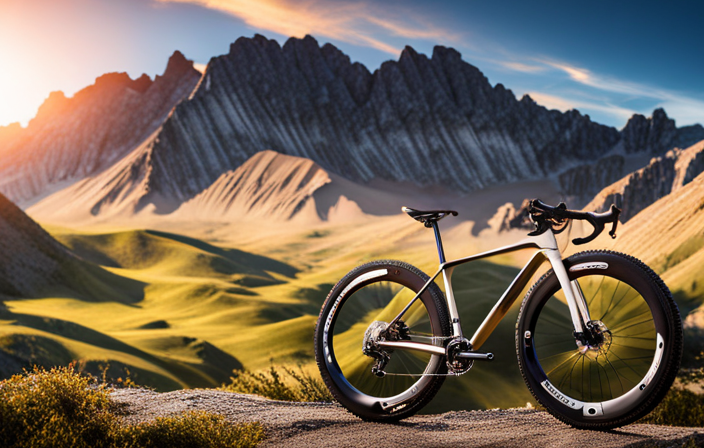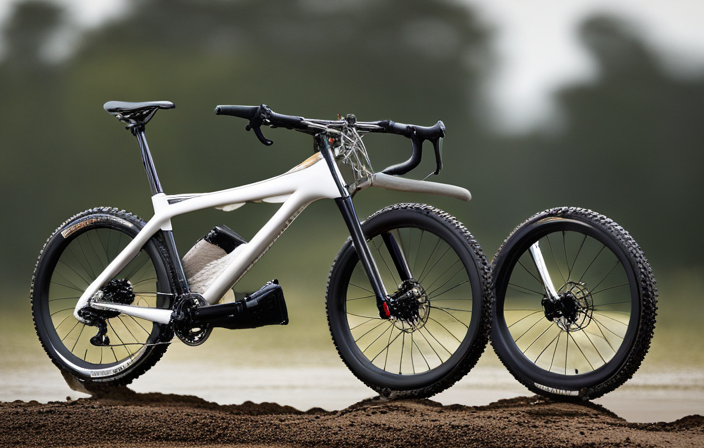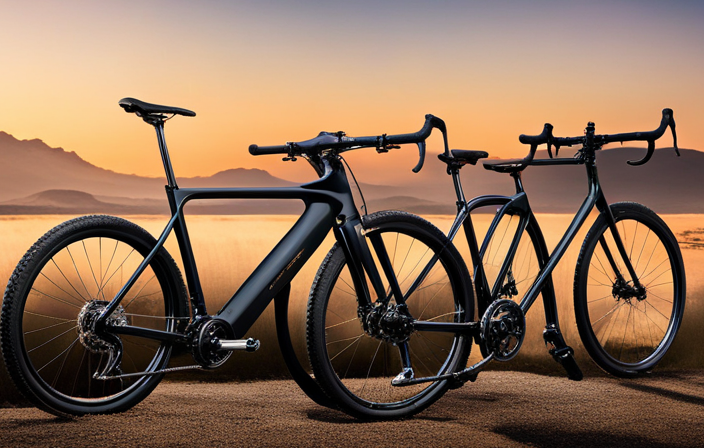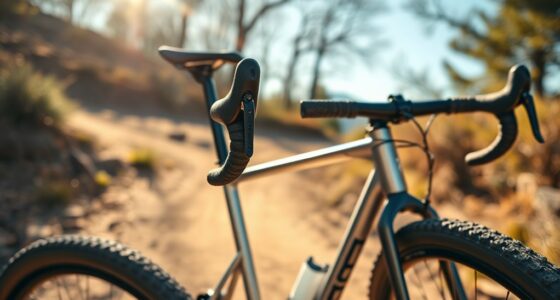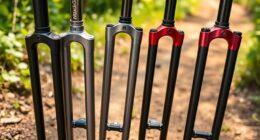Just as the gears of a well-maintained machine, the size of your chainrings is crucial in maximizing your gravel bike’s performance. With numerous choices available, it may seem like a daunting task to find the ideal fit. But fret not, fellow cyclist!
In this article, I will guide you through the intricacies of chainring sizes and help you make an informed decision based on your riding style, terrain, and personal fitness. Get ready to fine-tune your gravel riding experience and conquer any trail with confidence!
Key Takeaways
- Smaller chainrings provide easier climbing gears, while larger chainrings offer higher top speeds.
- Chainring selection depends on riding style and terrain.
- Balancing speed and power is crucial for optimal cycling performance.
- Experiment with different chainring sizes based on desired use of the bike.
Understanding the Basics of Chainring Sizes
Understanding the basics of chainring sizes is crucial when determining what size chainrings to use for a gravel bike. The gear ratio optimization and chainring selection criteria play a significant role in achieving optimal performance on different terrains.
When it comes to gear ratio optimization, it’s important to find the right balance between high-speed capabilities and low-end climbing power. This can be achieved by selecting chainrings with appropriate tooth counts. Generally, smaller chainrings with fewer teeth provide easier climbing gears, while larger chainrings with more teeth offer higher top speeds.
Chainring selection criteria also depend on your riding style and terrain. If you prefer tackling challenging off-road trails or steep climbs, choosing smaller chainrings would be beneficial as they provide a lower gear range for better control and pedaling efficiency. On the other hand, if you enjoy speed on flatter surfaces or long stretches of road, larger chainrings would allow you to maintain higher speeds without spinning out too quickly.
Consider your riding style and terrain when determining what size chainrings to use for your gravel bike. By understanding the basics of chainring sizes and considering these factors, you can optimize your gear ratios and enhance your overall riding experience without compromising performance.
Consider Your Riding Style and Terrain
To determine the appropriate chainring setup for your gravel riding, consider your personal style of riding and the type of terrain you typically encounter. This will ensure you have the right gear ratios for any challenges you may face while bikepacking or maintaining your gravel bike.
If you prefer a more aggressive riding style and often push hard on steep climbs, smaller chainrings can be beneficial. A compact crankset with 46/30 teeth or even smaller can provide lower gears, allowing you to maintain a comfortable cadence while tackling challenging ascents. Conversely, if you enjoy spinning at higher speeds and have flatter terrain, larger chainrings like 50/34 or even 52/36 may suit your needs better.
Consideration should also be given to the type of terrain you frequently encounter. If your rides consist mostly of technical off-road trails with lots of climbing, smaller chainrings will give you more control and power in these situations. However, if most of your rides involve long stretches of smooth gravel roads or pavement, larger chainrings can help optimize your efficiency at higher speeds.
Understanding how your personal style of riding and typical terrain impact gear selection is crucial when choosing the right chainring setup for your gravel bike. By taking these factors into account, you’ll be able to find a setup that maximizes both comfort and performance during your adventures on two wheels.
In the next section about gear ratios and cadence…
Gear Ratios and Cadence
When considering gear ratios and cadence, it’s important to find a setup that matches your riding style and the terrain you encounter. Finding the optimal cadence is crucial for efficiency and power output during gravel riding. Cadence refers to the speed at which you pedal, measured in revolutions per minute (RPM). The ideal cadence varies depending on factors such as fitness level, personal preference, and the type of terrain you’re riding on.
Factors affecting gear ratio selection include the steepness of climbs, rolling resistance of the surface, and your own strength and endurance. For steep climbs or rough terrains, lower gear ratios are preferable as they provide more torque for easier pedaling. On flatter sections or smoother surfaces, higher gear ratios allow for faster speeds with less effort.
To determine the appropriate gear ratios for your gravel bike, consider experimenting with different combinations to find what feels comfortable for you. It may take some trial and error to discover the perfect balance between cadence and gear ratio that suits your riding style.
The impact of chainring size on gear range will be discussed in the subsequent section.
The Impact of Chainring Size on Gear Range
Finding the right chainring size can greatly affect the gear range available to you while riding. The size of your chainrings will determine the number of teeth and therefore, the range of gears that you can access. A larger chainring will provide a higher gear ratio, allowing for faster speeds on flat terrain or descents. On the other hand, a smaller chainring will offer a lower gear ratio, which is beneficial for climbing steep hills or riding in challenging conditions.
When considering chainring size and its impact on gear range, it is important to also consider your optimal cadence. Cadence refers to the speed at which you pedal and finding the right balance between speed and power is crucial for efficient cycling. With larger chainrings, you may find yourself pedaling at a higher cadence to maintain an optimal speed. Conversely, smaller chainrings allow for a lower cadence but provide more power per pedal stroke.
In summary, choosing the right chainring size is essential for optimizing your gear range and ensuring that you have options for various terrains and riding conditions. It is important to consider both your desired gear ratios and your optimal cadence when making this decision. By finding the right balance between speed and power, you can enhance your overall cycling experience without compromising performance or efficiency in any given situation.
Finding the Right Balance between Speed and Power
Achieving the perfect balance between speed and power is crucial for optimizing your cycling performance. When it comes to gravel biking, finding the right chainring size plays a significant role in achieving this balance.
A larger chainring will allow you to pedal at higher speeds, making it ideal for those who prioritize speed on flat terrain or descents. On the other hand, a smaller chainring offers more power and better climbing ability, making it suitable for tackling steep inclines or rough terrains during bikepacking trips.
To optimize efficiency on your gravel bike, consider your riding style and terrain preferences. If you enjoy long-distance rides or bikepacking adventures with lots of climbing involved, a smaller chainring may be the better choice. It will provide you with the necessary power to conquer challenging ascents while maintaining an efficient cadence.
However, if you prioritize speed over climbing ability and prefer flatter routes or rolling hills, a larger chainring might be more suitable. It will allow you to maintain higher speeds without exerting excessive energy.
Finding the right balance between speed and power is essential for any cyclist looking to maximize their performance on a gravel bike. By choosing the appropriate chainring size based on your riding style and terrain preferences, you can ensure that every pedal stroke counts towards an optimized cycling experience.
When considering the trade-off between chainring size and chainring wear…
The Trade-Off between Chainring Size and Chainring Wear
To optimize your cycling experience, it’s important to consider the trade-off between the size of your chainring and how quickly it may wear out. The gear ratio provided by your chainring plays a crucial role in determining your speed and power output on the gravel bike. A larger chainring will give you more top end speed, allowing you to pedal faster on flat surfaces or descents. However, this comes at a cost – increased chainring wear and tear.
When you opt for larger chainrings, the increased tension in the drivetrain can lead to more stress on the components, causing them to wear out faster. The constant pressure exerted by each rotation of the pedals can result in accelerated wear on both the chainring teeth and the chains themselves. This means that you may need to replace these parts more frequently than if you were using smaller chainrings.
Finding a balance between speed and durability is essential. While larger chainrings offer higher speeds, they come with an increased risk of wearing out sooner. On the other hand, smaller chainrings provide better longevity but sacrifice some top-end speed potential.
Considering this trade-off between gear ratio and chainring wear will help you make an informed decision about what size chainrings are best suited for your gravel bike’s needs and riding style.
[Transition] Now let’s explore another crucial aspect when selecting chainrings for your gravel bike – compatibility with your bike’s drivetrain system.Compatibility with Your Bike’s Drivetrain
When selecting chainrings for your gravel bike, it’s important to ensure compatibility with the drivetrain system on your bike. Choosing the right chainring size can greatly impact your riding experience and performance on different terrains.
To help you make an informed decision, here are some key considerations:
-
Riding Techniques: The size of your chainrings can affect how you tackle various riding techniques. Smaller chainrings, such as a 46/30T combination, offer easier gear ratios for climbing steep hills or navigating technical off-road sections. On the other hand, larger chainrings like a 50/34T setup provide more top-end speed for flat or rolling terrain.
-
Maintenance Tips: Chainring wear is inevitable over time due to constant pedaling and exposure to dirt and debris. However, opting for durable materials like aluminum alloy or stainless steel can prolong their lifespan. Regular cleaning and lubrication will also help minimize wear and maintain smooth shifting performance.
-
Drivetrain Compatibility: Ensure that the chainrings you choose are compatible with your bike’s drivetrain components such as front derailleur, rear derailleur, and cassette. Different brands may have specific requirements, so consult your bike manufacturer’s guidelines or seek advice from a professional mechanic if unsure.
By considering these factors when selecting chainrings for your gravel bike, you’ll be able to optimize your riding experience based on your preferred techniques while also ensuring proper maintenance of your drivetrain system.
Now let’s move on to evaluating your current chainring setup and determining any necessary adjustments.
Evaluating Your Current Chainring Setup
Take a moment to assess your current setup and determine if any adjustments are needed. Evaluating your current chainring setup is crucial when considering the size of chainrings for your gravel bike. By understanding the potential benefits and drawbacks, you can make an informed decision that optimizes your riding experience.
Firstly, consider the size of your current chainrings. Are they providing you with the desired gear ratios for different terrains? Smaller chainrings, such as a 46/30T or 48/32T, offer easier climbing gears while sacrificing top-end speed. On the other hand, larger chainrings like a 50/34T or 52/36T provide more speed on flat roads but may limit your ability to conquer steep gradients.
Additionally, take into account how well your current chainrings match with other components in your drivetrain. Is there smooth shifting between gears or any noticeable grinding? Ensuring compatibility between chainring sizes and front derailleur capacity is essential for optimal performance.
By evaluating these aspects of your current setup, you can determine whether adjusting the size of your chainrings will yield any improvements in terms of gear range and overall ride quality. Transitioning into experimenting with different chainring sizes allows you to find the perfect combination that suits both your riding style and terrain conditions without compromising performance.
Experimenting with Different Chainring Sizes
Now that you’ve evaluated your current chainring setup, it’s time to start experimenting with different chainring sizes to fine-tune the performance of your gravel bike.
This step is crucial in optimizing your riding experience and getting the most out of your bike.
When it comes to choosing the right chainring size, there are a few factors to consider.
Firstly, think about how you want to use your bike. Are you looking for more speed on flat terrain or better climbing abilities? Adjusting the chainring size can help achieve these goals.
Secondly, take into account your own fitness level and strength. A smaller chainring will provide easier gears for riders who prefer spinning at higher cadences, while a larger chainring will offer more power for those looking to push harder.
Lastly, consider the weight of your bike. If you’re aiming for a lighter setup, opting for smaller chainrings can help reduce overall weight without sacrificing too much performance.
By experimenting with different chainring sizes and finding what works best for you, you’ll be able to fine-tune your gravel bike’s performance to match your specific needs and preferences.
But before making any final decisions on which size(s) to go with, consulting with experienced riders or visiting a local bike shop can provide valuable insights and recommendations tailored specifically to your riding style and terrain.
Consulting with Experienced Riders or Bike Shops
To get the most accurate insights and recommendations for your riding style and terrain, it’s best to consult with experienced riders or visit a local bike shop. When it comes to chainring sizes for a gravel bike, these experts can provide valuable advice based on their own experiences and knowledge.
Bike shops in particular are equipped with the expertise and resources to help you find the right chainring size that suits your specific needs. Visiting a bike shop has several benefits when it comes to choosing chainrings. They have a wide range of options available, allowing you to try out different sizes before making a decision. Additionally, the staff at bike shops are knowledgeable about various riding styles and terrains, so they can offer personalized recommendations based on your preferences and goals.
Consulting with experienced riders is also beneficial because they have firsthand experience with different chainring sizes. They can share their insights on how different sizes affect performance, efficiency, and overall ride feel. These riders may have tried various setups themselves and can provide valuable feedback based on their own trials.
By seeking advice from both experienced riders and bike shops, you can gather a wealth of information that will guide you in choosing the right chainring size for your gravel bike. Taking into account factors such as your riding style, terrain, and personal preference will help ensure an optimal setup for your adventures ahead without compromising performance or comfort.
Factors to Consider for Bikepacking or Loaded Touring
When considering bikepacking or loaded touring, it’s important to take into account the weight distribution and load capacity of your bicycle. This will ensure a comfortable and safe journey, as well as prevent any potential damage to your bike.
To help you make the best choices for your adventure, here are three key factors to consider when choosing the right gear ratios for bikepacking essentials:
-
Terrain: The type of terrain you’ll encounter during your trip plays a crucial role in determining the ideal gear ratios. Steep climbs require lower gears to provide enough power and control, while flat sections or descents may require higher gears for efficient pedaling.
-
Weight: The additional weight from your gear and supplies can significantly affect how easily you can pedal and maintain speed. Choosing lower gear ratios will give you more leverage to handle the extra load without putting excessive strain on your legs.
-
Distance: Long-distance rides often call for a wider range of gear ratios to accommodate varying terrains and fatigue levels over time. Having a good mix of low, medium, and high gears will allow you to efficiently tackle different sections of your route.
Considering these factors when choosing your gear ratios will greatly enhance your bikepacking experience.
Next, we’ll explore the influence of rider fitness and strength on finding the perfect chainring size for gravel biking adventures without compromising performance or comfort.
The Influence of Rider Fitness and Strength
Rider fitness and strength play a significant role in determining the ideal gear ratios for a comfortable and efficient bikepacking or loaded touring experience. When it comes to bike fit, having the right chainring size can make all the difference in how easily you can pedal over various terrains while carrying a load. Additionally, proper nutrition optimization is crucial to ensure that your body has the energy and stamina necessary for long rides.
To help you understand how rider fitness and strength impact gear ratios, I have created a table below:
| Fitness Level | Strength Level | Ideal Chainring Size |
|---|---|---|
| Beginner | Low | Smaller |
| Intermediate | Medium | Medium |
| Advanced | High | Larger |
As you can see from the table, riders with higher fitness levels and greater strength will benefit from larger chainrings, as they can generate more power with each pedal stroke. On the other hand, beginners or those with lower strength levels may find smaller chainrings more suitable for easier pedaling.
In the next section, we will explore potential modifications for fine-tuning performance without compromising comfort.
Potential Modifications for Fine-Tuning Performance
When it comes to optimizing the performance of your gravel bike, there are a few potential modifications that can help fine-tune your riding experience.
One important aspect to consider is the suspension performance. The right setup can greatly enhance your comfort and control on rough terrain. Adjusting the suspension settings such as rebound, compression, and sag can make a noticeable difference in how the bike handles bumps and impacts.
Another key factor to consider is tire pressure. Different terrains require different levels of tire pressure for optimal performance. Lower pressures provide better traction on loose surfaces like gravel or dirt, while higher pressures are ideal for smoother roads or hard-packed trails. Experimenting with different tire pressures can help you find the sweet spot for each type of terrain you ride on.
By making these small adjustments, you can fine-tune your gravel bike to perform at its best in various conditions.
Now that we’ve looked at potential modifications for enhancing performance, let’s move on to considering the overall weight of the bike and its impact on ride quality and efficiency.
Considering the Overall Weight of the Bike
Considering the overall weight of your gravel bike can have a significant impact on ride quality and efficiency. When determining the optimal chainring size for your bike, it is crucial to take into account its weight. A heavier bike requires more effort to pedal, especially when climbing or riding on rough terrain. By choosing the right chainring size, you can optimize your pedaling efficiency and make the most out of every ride.
To help you understand how bike weight affects chainring selection, let’s look at a comparison table:
| Bike Weight | Optimal Chainring Size |
|---|---|
| Lightweight | Smaller |
| Moderate | Medium |
| Heavy | Larger |
As you can see from the table, lighter bikes generally perform better with smaller chainrings, while heavier bikes benefit from larger ones. This correlation is due to the mechanical advantage provided by different gear ratios.
By considering your gravel bike’s weight and selecting an appropriate chainring size, you can enhance your riding experience by improving efficiency and reducing fatigue. Now that you have a better understanding of this aspect, let’s move on to finalizing your decision and enjoying the ride!
Finalizing Your Decision and Enjoying the Ride!
To wrap up your decision-making process, make sure to take into account all the factors we discussed and get ready to enjoy an amazing ride!
Now that you have considered the overall weight of your gravel bike and its impact on chainring selection, it’s time to finalize your decision and focus on fine-tuning comfort and optimizing efficiency.
Here are some key points to keep in mind as you make your final choices:
-
Consider your riding style: Are you more focused on speed or endurance? This will help determine the optimal chainring size for you.
-
Evaluate terrain: If you expect a lot of steep climbs, a smaller chainring may be more suitable. For flatter routes, a larger chainring could provide better efficiency.
-
Gear range: Ensure that the combination of your front and rear chainrings gives you a wide enough gear range for all types of terrain you plan to tackle.
-
Experiment: Don’t be afraid to try different sizes and see what works best for you. Everyone’s preferences are unique!
-
Seek professional advice: If you’re unsure about which size is right for you, consult with a knowledgeable bike shop or experienced riders who can offer guidance based on their expertise.
By considering these factors and making informed decisions regarding chainring size, you’ll be well on your way to enjoying a comfortable and efficient ride on your gravel bike.
Frequently Asked Questions
Can I use different chainring sizes on my front and rear gears?
Yes, you can use different chainring sizes on your front and rear gears. However, it’s important to consider chainring compatibility to ensure smooth shifting and optimal performance.
When using different sizes, it’s crucial to properly maintain your chainrings. Regular cleaning and lubrication will prevent build-up of dirt and grime, ensuring smooth operation.
Additionally, regularly checking for wear and replacing worn chainrings will extend their lifespan and maintain the overall efficiency of your bike’s drivetrain.
How do I determine the ideal chainring size for my riding style and terrain?
When determining the ideal chainring size for your riding style and terrain, it’s important to consider how chainring sizes affect climbing ability and what chainring size is best for long distance endurance rides.
Smaller chainrings provide easier gearing, making climbs more manageable by reducing the effort required. On the other hand, larger chainrings offer higher top-end speed but can be more challenging on steep climbs.
For long distance endurance rides, a balance between efficiency and comfort is key, so a mid-range chainring size may be most suitable.
What are the benefits of a larger chainring size?
A larger chainring size on a gravel bike offers several benefits.
Firstly, it allows for optimal gear ratios, meaning you can find the perfect balance between speed and torque for various terrains.
Secondly, it improves efficiency and power output by enabling you to generate more force with each pedal stroke. This results in increased speed and better climbing capabilities.
Overall, opting for a larger chainring size can greatly enhance your riding experience on a gravel bike.
Are there any potential drawbacks of using smaller chainrings?
There are potential drawbacks to using smaller chainrings. One drawback is decreased top-end speed, as smaller chainrings require higher cadence to maintain the same speed.
Additionally, climbing steep hills may be more challenging with smaller chainrings, as they provide less leverage.
Using smaller chainrings may also necessitate adjustments to the rear derailleur and cassette to ensure proper shifting.
However, these potential disadvantages can be mitigated by choosing the appropriate gear ratios and making necessary bike adjustments.
How often should I replace my chainring to prevent excessive wear and tear?
To prevent excessive wear and tear on my chainring, it’s important to replace it regularly.
The ideal chainring size can vary depending on factors such as terrain, riding style, and personal preference.
However, regardless of the size, regular inspection is crucial to identify signs of wear like tooth profile deformation or excessive wear on the teeth.
Generally, replacing the chainring every 2,000-5,000 miles is recommended to maintain optimal performance and prolong its lifespan.
Conclusion
In conclusion, finding the right size chainrings for your gravel bike is crucial for optimizing your performance on various terrains. By considering factors such as riding style, terrain, gear ratios, and cadence, you can strike the perfect balance between speed and power.
Don’t forget to take into account your own fitness and strength levels when making this decision. And if you ever feel like fine-tuning your performance or adjusting the weight of your bike, there are always potential modifications to explore.
So go ahead and finalize your chainring choice – it’s time to hit the gravel and enjoy the ride!
